First Year
Introduction
JSA-ASEAN Conference, Dec. 16, 2021
Japan-Korea relations are emerging as an important issue in the Indo-Pacific region. Despite the current bad relationship and mismanagement of historical issues between the two countries, the relationship is being overlooked for its potential. As the regional landscape is changing with the rise of China, postwar stability and the establishment in the Indo-Pacific are being challenged, giving new significance to Japan-Korea relations in influencing the future of the region.
Particularly, cooperation between Japan and South Korea has potential to keep the Sino-American power relationship in balance, helping states in the region avoid the obligation to take sides with either the US or China. This is important since the Indo-Pacific is a highly interdependent region and decoupling from China or the US is not a viable option for any state in the region. ASEAN in this context is a point of convergence between Japan and South Korea, where they both have interest in promoting democratic norms and the rule of law, as well as development projects. Collaboration on non-traditional security issues in ASEAN states could help Japan and South Korea sidestep historical issues and open the door for communication, which could have a spillover effect of improving relations between the two countries overall.
In the past, much of the discussion over the Japan-Korea bilateral relationship has taken place in either Japanese or Korean language forums, leaving room for criticism by nationalists in both countries. This project is an attempt to move into a more neutral space by holding discussions in English, and also involving members that are not specialists on Japan-Korea relationships, but on a variety of other issues, and share the view that the bilateral relationship has an important role for the future of the region.
Particularly, cooperation between Japan and South Korea has potential to keep the Sino-American power relationship in balance, helping states in the region avoid the obligation to take sides with either the US or China. This is important since the Indo-Pacific is a highly interdependent region and decoupling from China or the US is not a viable option for any state in the region. ASEAN in this context is a point of convergence between Japan and South Korea, where they both have interest in promoting democratic norms and the rule of law, as well as development projects. Collaboration on non-traditional security issues in ASEAN states could help Japan and South Korea sidestep historical issues and open the door for communication, which could have a spillover effect of improving relations between the two countries overall.
In the past, much of the discussion over the Japan-Korea bilateral relationship has taken place in either Japanese or Korean language forums, leaving room for criticism by nationalists in both countries. This project is an attempt to move into a more neutral space by holding discussions in English, and also involving members that are not specialists on Japan-Korea relationships, but on a variety of other issues, and share the view that the bilateral relationship has an important role for the future of the region.
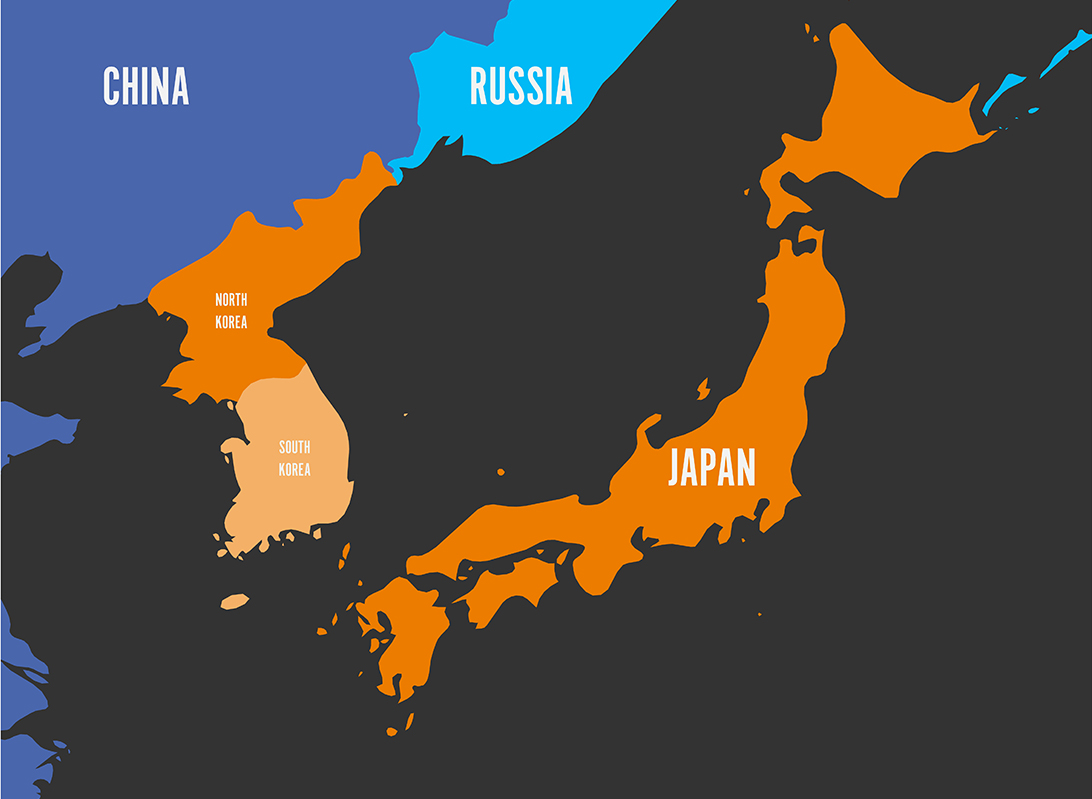
Participants
- Haruko Satoh, Osaka School of International Public Policy (Moderator)
- Philip Shetler-Jones, Council on Geostrategy
- Kei Koga, School of Social Sciences, Nanyang Technological University
Panelists’ Remarks
The following is a summary of key points provided by each panelist –

Discussion
Areas of development each country focuses on in Mekong and potential places to work together
Both Japan and South Korea have focused on projects such as water management, human development, and technology such as early warning systems for disasters. However, it’s not clear what each country is actually doing in the region, since the information is not publicized. The first step is to create an information sharing center to identify ongoing projects and areas of overlap between Japan and Korea. A cooperative framework within existing institutions like ASEAN could create a forum for this.
Elaboration on using ASEAN +3 as a forum
Mr. Koga proposed this idea based on the experience of Japan-China cooperation in the past. In 2006-2010, the two countries communicated bilaterally and shared information on Mekong development programs, but lines of communication ultimately collapsed because of politicization. This shows that in bilateral relations, channels of communication can be built, but politicization can cut off these channels. Using an existing multilateral framework can preserve the lines of communication more effectively. Additionally, external powers like Japan and Korea could be effective in putting Mekong on the agenda for ASEAN in general.
Influence of the Quad and US-China Relations
In the beginning, the Quad was molded almost in reaction to what China was doing. Its shift to a focus on infrastructure development and vaccines show that the Quad is no longer ignoring Southeast Asia. A Quad+ format could be flexible in including other countries, but its potential depends on how US stance towards China is going to evolve.
Under the Biden administration, the fundamental US posture towards China has remained same as Trump administration, but the middle powers, such as Japan and South Korea, are not aligning themselves with the US approach to China. This could be their strength – they have the same democratic principles and values as the US, but are more open to communication and collaboration with China. This could give them room to approach other countries, facilitating their ability to promote the rule of law and human rights in ASEAN.
Under the Biden administration, the fundamental US posture towards China has remained same as Trump administration, but the middle powers, such as Japan and South Korea, are not aligning themselves with the US approach to China. This could be their strength – they have the same democratic principles and values as the US, but are more open to communication and collaboration with China. This could give them room to approach other countries, facilitating their ability to promote the rule of law and human rights in ASEAN.
Current importance of the Japan-Korea relationship
The main incentive for improving Japan-Korea bilateral relations is intensification of US-China strategic competition. In this context, the Mekong region is becoming more geopolitically important, creating divisions in the region which are not good for ASEAN or South Korea. Similarly, Japan aligning more closely with the US would create division among ASEAN member states, which wouldn’t be strategically beneficial for Japan.
Japan and South Korea, through collaboration, have an opportunity to mitigate US-China geopolitical competition over Mekong region development. Both countries want to see more ASEAN autonomy in East Asia, and share strategic interests to cooperate even if they don’t perfectly align.
Japan and South Korea, through collaboration, have an opportunity to mitigate US-China geopolitical competition over Mekong region development. Both countries want to see more ASEAN autonomy in East Asia, and share strategic interests to cooperate even if they don’t perfectly align.
Impact of the negative UK-EU relationship on European engagement in the Indo-Pacific
There is no single coherent European approach to the Indo-Pacific; different ideas exist within the EU, not just between the UK and the EU. There is economic competition between European countries in their Indo-Pacific region ventures, but that was present when UK was in the EU as well. What has changed is that the current government in the UK came to power on the Brexit policy and is expected to deliver on the idea of British influence extending far beyond Europe – for example, by joining trade agreements in Asia such as the CPTPP. This does not inhibit the EU in its policy toward the Indo-Pacific, and the EU’s success will be determined by other factors. Additionally, as the Biden administration opens to more collaboration with allies, the EU is finding a better partner in Washington than in the past. This means the difference between the EU and UK in terms of willingness to algin with the US is decreasing, showing movement toward harmonization of interests.
Second Year
May 1, 2022 to April 30, 2023
Activities During the Grant Period
This project grew from the previous project “Korea and Japan in the Evolving China-US Relations” (2019-2021) project, in order to build an inter- and transnational policy-discussion channels in which effective Japan-South Korea partnership can be meaningfully developed. It focuses on Asian non-traditional security and peacebuilding issues from the perspective of the concept of human-centric notion of security, where regional and international collaboration is the norm. It aims to build a network of practitioners, researchers and policymakers, to identify and discuss areas of potential Japan-South Korea cooperation, where the two countries’ working together are beneficial to the strategic stability of the Indo-Pacific region. To this end, the project is also conscious of signaling to partners in the West that the traditional (and strong) image of the donor-recipient hierarchy should be replaced with the sense of partnership with Asia toward building resilient societies to complex threats. As an important spill-over we had hoped to encourage policy discussions for greater policy harmonization of Japan’s Free and Open Indo-Pacific vision and South Korea’s New Southern policy vision, where the two countries’ overall strategic interests in ASEAN and more recently in India have significant overlaps. Greater coordination and collaboration between Japan and South Korea as significant democratic powers is believed to be in the mutual benefit of all stakeholders in the region in the post-COVID world, where middle/middling powers must hedge against US-China rivalry. Eventually, we seek to establish a “Centre for Peace and Human Security in Asia” as part of the IAFOR Research Centre, OSIPP, Osaka University that combines both online graduate school level education module for peacebuilding and human security and a joint Japan-ROK hub for exchange and information among policymakers, practitioners and researchers with the Ehwa Womans University’s Graduate School of International Studies.
The second year of this multi-year project (3-years) focused on deepening collaboration around two key organizational partners, the Association of Asian Studies (AAS) and the Asian Political and International Studies Association (APISA), in addition to the contacts with the Leiden AsiaCentre, the Konrad Adenauer Stiftung office in Tokyo, the Australian Institute of International Affairs (with which IAFOR is running an Australia-Japan-US roundtable series funded by the US Department of State), the East West Center-DC, the University of Michigan Gerald Ford School of Diplomacy, Mindanao State University, Central Luzon State University, and the Korea Centre at the EAI, National University of Singapore. We have also established new links with the Brussels School of Governance and the European Centre for Peace and Development (ECPD, Belgrade). The capstone event of this year’s project was the first AAS Symposium for the Cultivating the Humanities and Social Sciences for the Underrepresented in South and Southeast Asia Initiative (CHSS), held at Chiang Mai University in Thailand, in December 2022, where it was followed by the APISA congress (the first in-face gathering since 2019). The main achievement of this joint event was that it brought two academic conferences together in Chiang Mai, as the first major “in face” gathering of key collaborators in this project since the pandemic.


Project Schedule
July:
Consultations
Online consultations with the collaborators (5th with the Rohingya Project; 13th with Ewha Womans University and AAS; 26th with Central Luzon State University); Standing project meeting on first Wednesday of the month.
July 28:
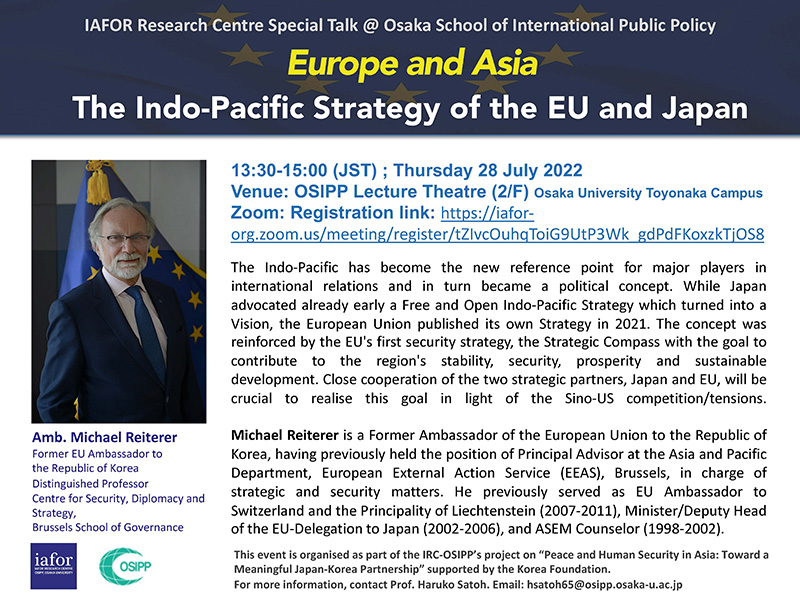
Special Lecture
IRC Special Lecture@OSIPP, “Europe and Asia: The Indo-Pacific Strategy of the EU and Japan” (Ambassador Michael Reiterer, Brussels School of Governance).
June-July:
Visiting Scholar
IRC visiting scholar to OSIPP, Anusorn Unno, Thammasat University, Thailand. (Special lecture on Thai politics and the monarchy at the Global Governance class.)
September:
Consultations
Online consultations with collaborators (1st with Mindanao State University and the Sasakawa Peace Foundation (SPF); Fair Observer Intelligence; 5th CSIS-Indonesia; Mindanao State University; 6th Ewha Womans University; 7th SPF; 8th Saya Kiba, Kobe City University; 16th Ewha Womans University); Standing project meeting on first Wednesday of the month.
September 23:
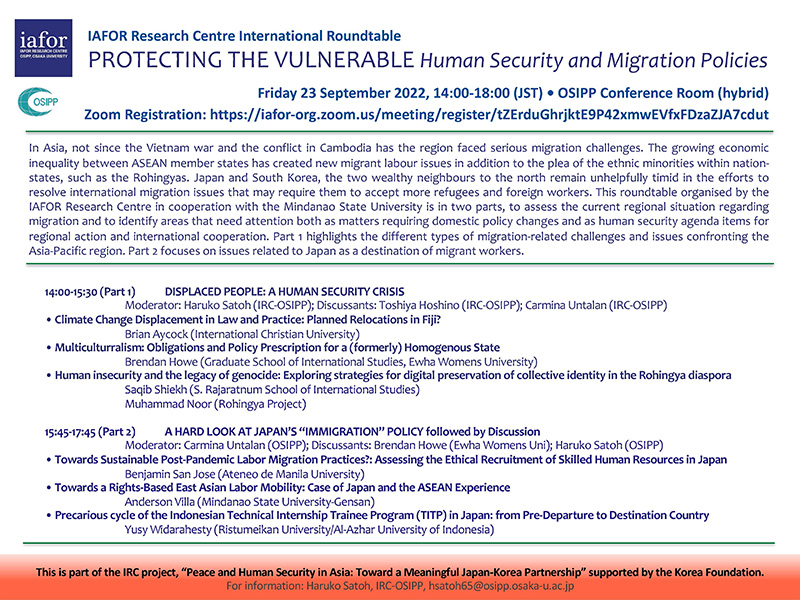
Workshop
Special workshop @OSIPP, “Protecting the Vulnerable: Human Security and Migration” with Mindanao State University (hybrid).
October:
Consultations
Online consultations with parters: 6th with AAS; 10th with authors of book project; 31st Fair Observer podcast meeting; Standing project meeting on first Wednesday of the month.
October 27:
Special Lecture
IRC Global Governance class Special Lecture @OSIPP, “War in Ukraine and the future of Europe and Asia”, Dr Eva Pejsova, Japan Chair, Centre for Security, Diplomacy and Strategy (CSDS), Brussels School of Governance.
October 27-28:
Sustainability Dialogue
Trans-Pacific Sustainability Dialogue Sponsored PhD candidate Darren Mangado to present at the “Development Cooperation for Sustainable Governance” student panel.
November:
Meetings
Online meetings (4th with Fair Observer; 9th with AAS; 15th with Central Luzon State University; 30th APISA & AAS coordinated meeting) Standing project meeting on first Wednesday of the month.
November 24:
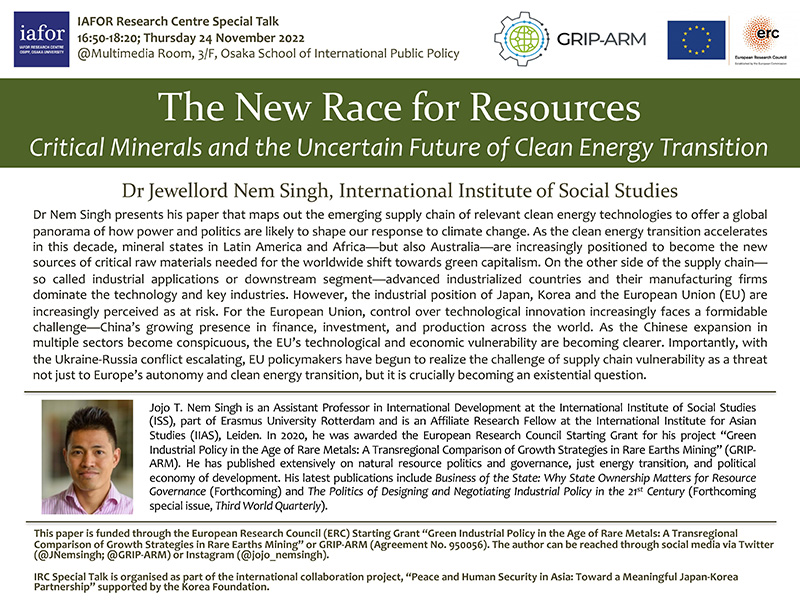
Special Lecture
IRC Global Governance Special Lecture, “The New Race for Resources: Critical Minerals and the Uncertain Future of Clean Energy Transition” (Dr Jojo Nem Singh, International Institute of Social Studies, the Netherlands).
December:
Meetings
Podcast planning meeting (Dec 2; 5); meeting with AAS (Dec 14); meeting with University of Michigan student intern (Dec 29).
December 8-10:
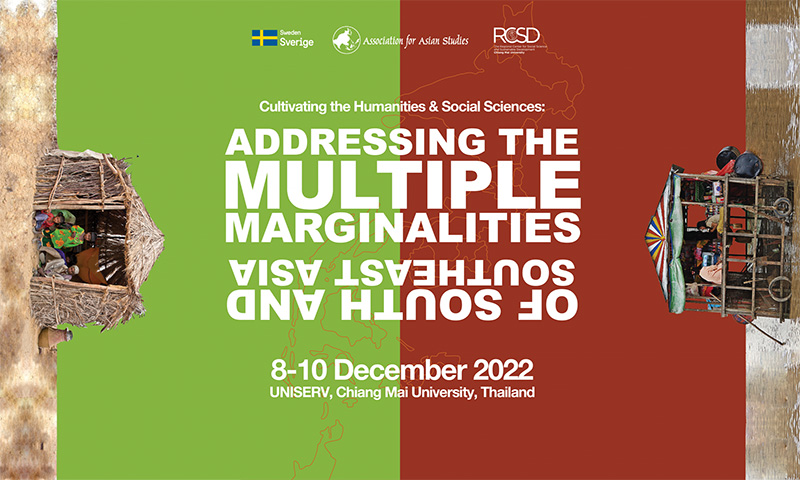
Symposium
AAS Symposium “Addressing the Multiple Marginalities of South and Southeast Asia @ Chiang Mai University, Thailand.
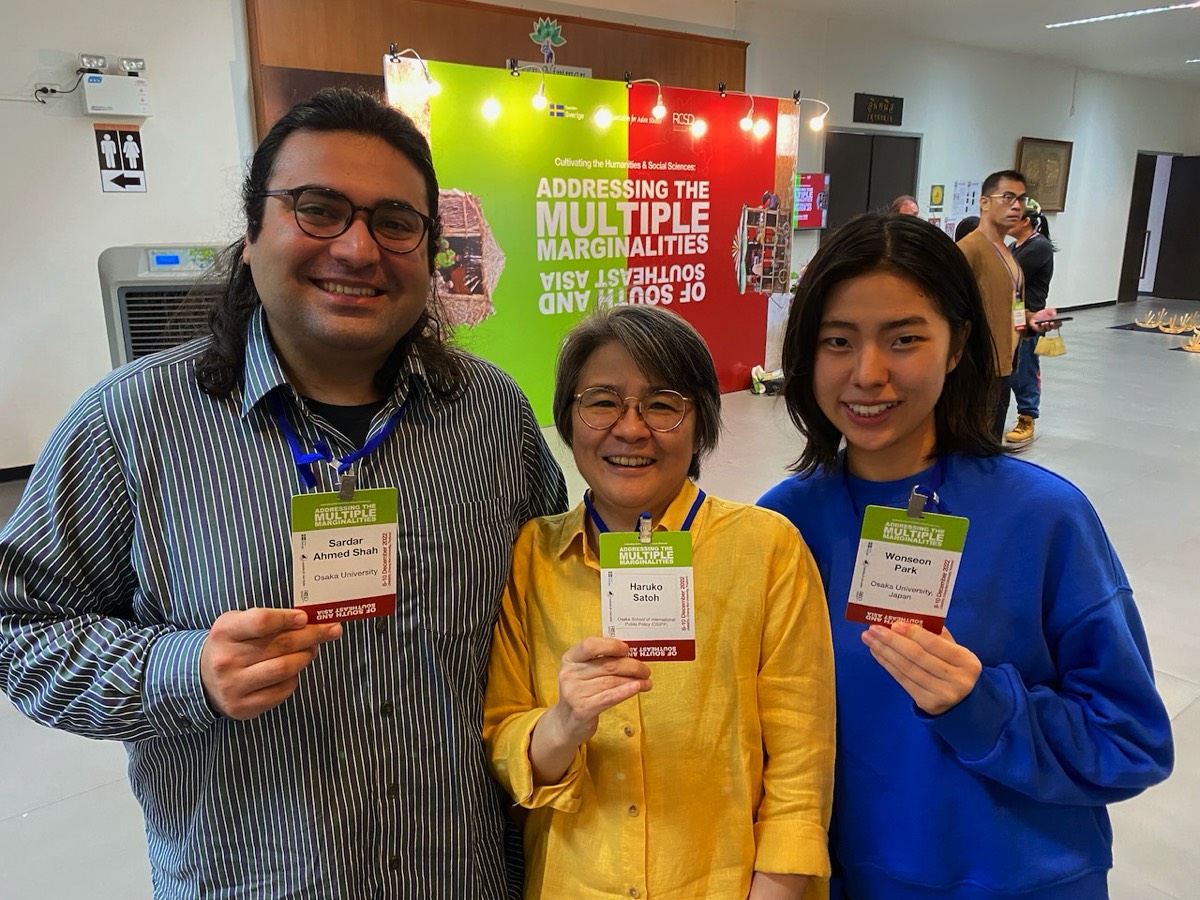
Read "Thoughts on AAS CHSS @ Chiang Mai University" Shah Sardar Ahmed is PhD students at Osaka School of International Public Policy, Osaka University. https://cultivatinghumanities.org/thoughts-on-aas-chss-chiang-mai-university/
December 10-11:
Symposium
APISA 2022 “World on Fire: Whither International Cooperation?” at Chiang Mai University, Thailand. Special Panel: “Enhancing Japan-Korea Partnership: New Horizons”
2023
January:
Project Meetings
Online meetings for book project.
January 27:
Joint Seminar
IPUS (Institute of Peace and Unification Studies) and IRC-OSIPP joint seminar on “Security in Northeast Asia”.
February:
Meetings
Online meetings (3rd with AAS; 22nd with Ewha Womans University and AAS; 24th APISA). February 10-13: IAFOR Southeast Asian Conference on Education (at Singapore EXPO, Singapore).
March:
Meetings
Online meetings (10th & 14th with Central Luzon State University; 14th with AAS; 29th with the Australian Institute for International Affairs.
March 15-19:
Panel Discussion
ISA Montreal (partial panel due to visa problem with one panelist).
March 18-25:
AAS Boston
AAS Boston (meetings with WISC World International Studies Committee and AAS Global Asia programme attended by Brendan Howe).
March 25-29:
ACEID Conference
IAFOR Asian Conference on Education and International Development (ACEID) in Toshi Centre, Tokyo. Featured panel on 27th: IAFOR’s collaborative Efforts: AAS and the IAFOR Research Centre with Krisna Uk (AAS), Brendan Howe (Ewha Womens University), Haruko Satoh (IRC-OSIPP).
April:
Meetings
Planning meetings to discuss new joint research projects (13th & 14th with AAS; 14th with Dr Nem Singh; 16th with Lahore University of Management Science).
Summary:

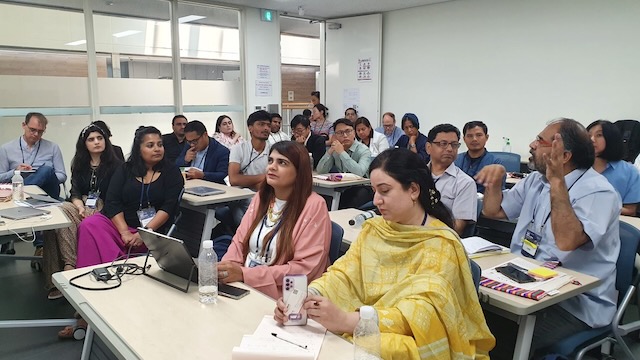
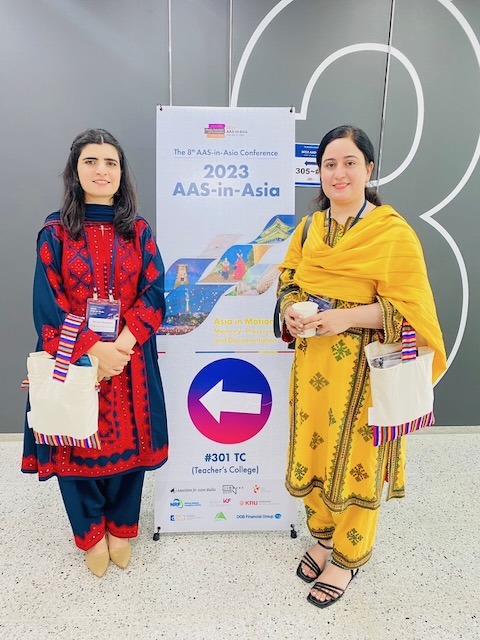
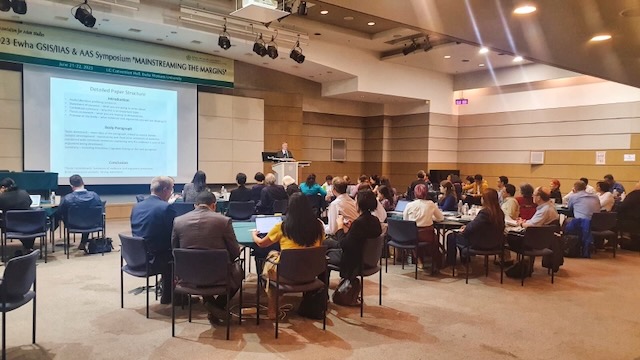

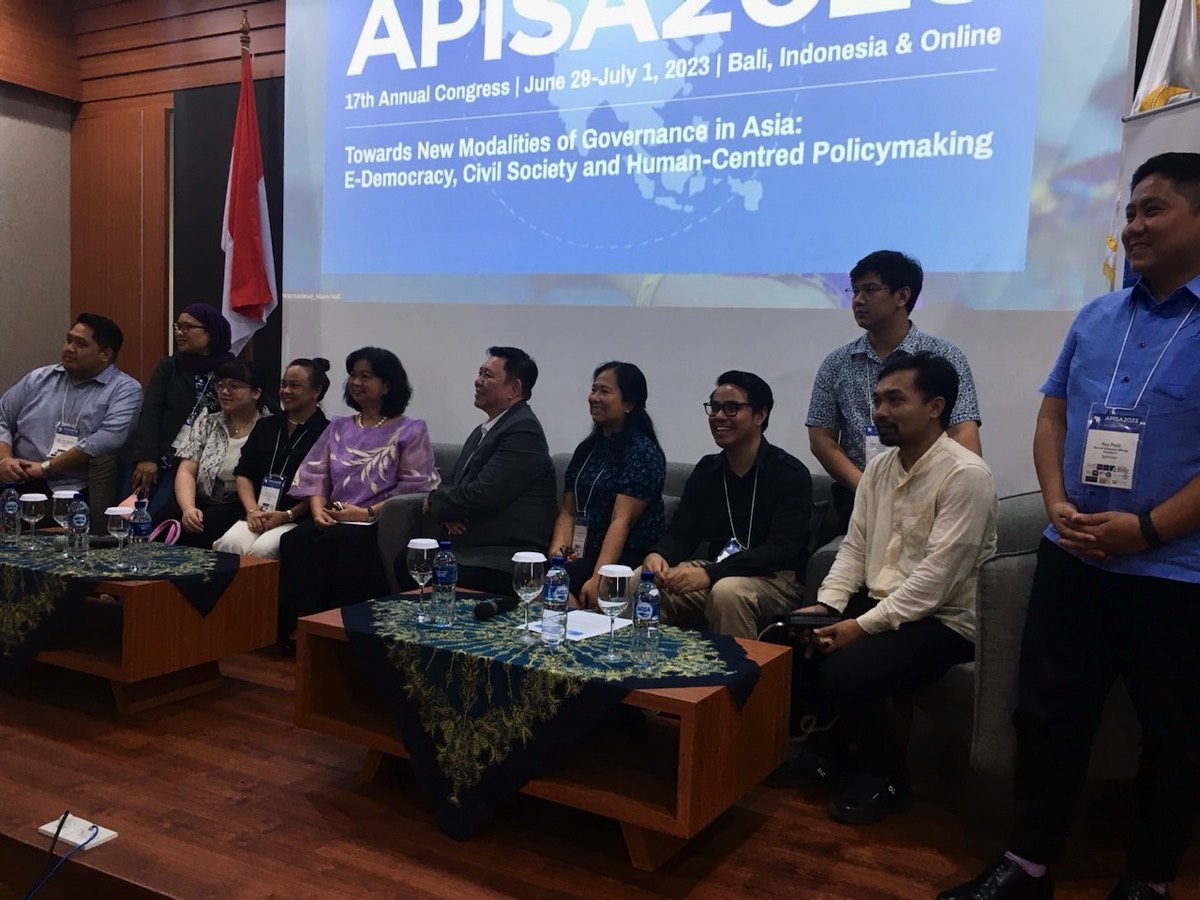
Outcome of the Project
The most significant event for this year and to this project was the joint event organised by the Asian Political and International Studies Association (APISA) and the Association of Asian Studies (AAS) Chiang Mai in December 2022, with the logistical help from IAFOR. The AAS-CHSS symposium that consisted of a series of capacity building workshops and the APISA conference, the first in-face conference since the pandemic, were held back-to-back with over 150 participants from both events interacting. This occasion consolidated the collaborative network as this project’s objectives were closely aligned with the interests and objectives of the two different academic groupings.
It is here important to note that the APISA congress was saved with this Korea Foundation project support, as the original funder to support the congress in September in Malaysia pulled out the last minute. As the KF project was already committed to contributing to the AAS-CHSS event in Chiang Mai, Brendan Howe and Haruko Satoh, both executive committee members of APISA, consulted IAFOR to act as the secretariat to hold APISA in Chiang Mai with AAS. This, in turn, led to a more formal arrangement for IAFOR to assist in the secretariat function of APISA.
It is here important to note that the APISA congress was saved with this Korea Foundation project support, as the original funder to support the congress in September in Malaysia pulled out the last minute. As the KF project was already committed to contributing to the AAS-CHSS event in Chiang Mai, Brendan Howe and Haruko Satoh, both executive committee members of APISA, consulted IAFOR to act as the secretariat to hold APISA in Chiang Mai with AAS. This, in turn, led to a more formal arrangement for IAFOR to assist in the secretariat function of APISA.
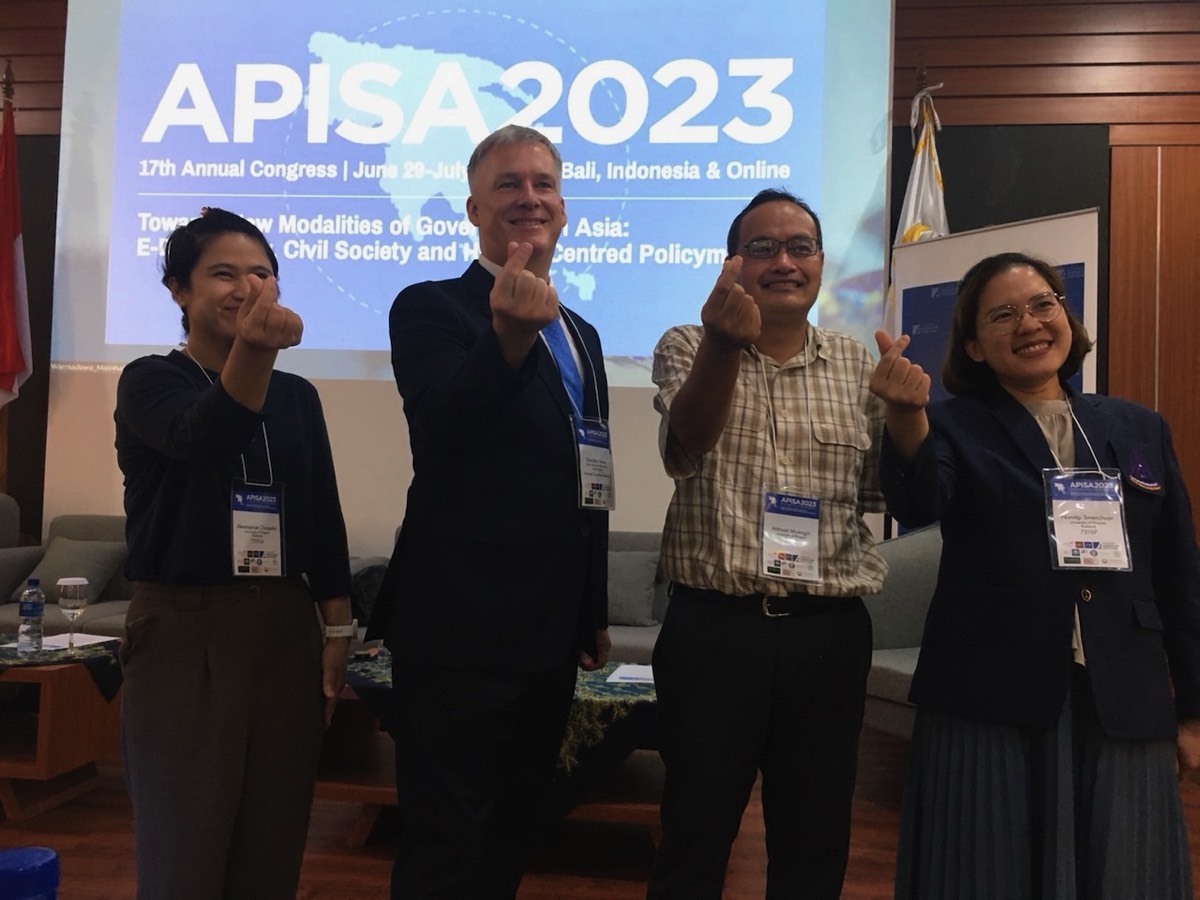
The year was also particularly difficult in adjusting the post-pandemic, gradual opening of borders, in addition to deteriorating international political environment due to the war in Ukraine and intensifying US-China rivalry. The war in Ukraine in particular forced to focus within their own professional positions in think tanks or universities on the implications of this crisis, and topics for podcasts and webinars needed to be rethought and rescheduled accordingly. This also led to delays in podcast production delays, and the overall written output from project members for this year has been limited to a few articles and podcasts.
Instead, the project focused on supporting young scholars working for the IAFOR Research Centre in various capacities to attend international events in our project orbit, as a way to build the capacity of the IRC as a training ground to work in think tanks or conference organisations. There is a reward for putting energy into supporting young scholars, as the key Research Assistant for the Korea Foundation projects in the past few years, Carmina Yu Untalan, upon completing her assistant professorship at OSIPP now helps the project in her position at the International Institute of Asian Studies at Leiden University since October 2022.
In other international conferences, Brendan Howe from project took part in the International Studies Association in Montreal and Association of Asian Studies in Boston in March 2023. Brendan Howe was also tasked with networking for the project, speaking to WISC (World International Studies Committtee) and taking part in the AAS’s Global Asia programme for possible collaboration in the future. Carmina Untalan and Haruko Satoh who were originally in the ISA panel could not go to Montreal, the fomer due to visa issues and the latter due to illness. Instead, we asked Hitomi Koyama of Leiden University to be the discussant for the ISA panel (and we supported her accommodation for this).
We are now excited now that the political atmosphere has improved between Japan and Korea, with new leaders in charge. As our interaction with the wider Asian scholars and experts intensify in quality and broaden in geographical scope (now we are also in the collaborative talks with scholars from India and Pakistan) scope, the need for Japan and Korea becomes all the more important and crucial to the stability of the Indo-Pacific region.
Instead, the project focused on supporting young scholars working for the IAFOR Research Centre in various capacities to attend international events in our project orbit, as a way to build the capacity of the IRC as a training ground to work in think tanks or conference organisations. There is a reward for putting energy into supporting young scholars, as the key Research Assistant for the Korea Foundation projects in the past few years, Carmina Yu Untalan, upon completing her assistant professorship at OSIPP now helps the project in her position at the International Institute of Asian Studies at Leiden University since October 2022.
In other international conferences, Brendan Howe from project took part in the International Studies Association in Montreal and Association of Asian Studies in Boston in March 2023. Brendan Howe was also tasked with networking for the project, speaking to WISC (World International Studies Committtee) and taking part in the AAS’s Global Asia programme for possible collaboration in the future. Carmina Untalan and Haruko Satoh who were originally in the ISA panel could not go to Montreal, the fomer due to visa issues and the latter due to illness. Instead, we asked Hitomi Koyama of Leiden University to be the discussant for the ISA panel (and we supported her accommodation for this).
We are now excited now that the political atmosphere has improved between Japan and Korea, with new leaders in charge. As our interaction with the wider Asian scholars and experts intensify in quality and broaden in geographical scope (now we are also in the collaborative talks with scholars from India and Pakistan) scope, the need for Japan and Korea becomes all the more important and crucial to the stability of the Indo-Pacific region.



